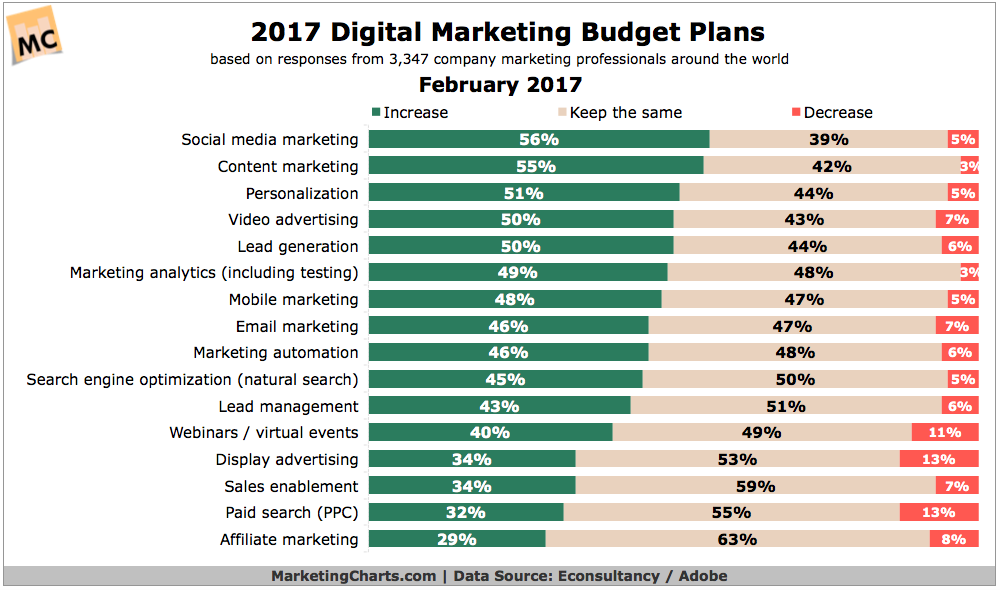Benjamin Franklin once said, “in this world, nothing can be said to be certain, except death and taxes.”
To be fair on Franklin, he said this way before digital marketing was a thing. Nowadays, it’s safe to say that, for certain, brands and retailers will not succeed unless you can connect with your buyers.
The number of businesses increasing their digital marketing budgets grows year-on-year. The average spend in the UK is £1686 per person. The average firm is expected to increase their online marketing budgets to 45% by 2020.
How much spend you allocate to your marketing strategy should be determined by several factors – all of which will be featured in this article.
Grab a pen, you’ll need to take some notes.
Determine Goals and Campaign Types
When calculating your marketing budget, determine where your company is in the grand scheme of things. Firstly, answer the following:
What is the size of your company?
How long have you been established?
What rate of growth do you need to achieve long-term goals?
What is your goal for this year?
The purpose of this exercise is to determine where you are and where you want to be. The next step is how to get there.
Which campaign types do you need to run and in which priority?
- Brand/product awareness
- Lead acquisition
- Fostering
- Capture
- Re-Acquisition
One last question to bear in mind – do you have a realistic budget that will enable you to reach your goal?
Let’s take a closer at that.

Plan Your Marketing Strategy
Although digital marketing strategies are different across certain industries and are almost certain to be unique from one company to the next, everybody has the same playing field.
How you play the game will depend on how you plan to reach your audience and whether you need to raise product and brand awareness.
Make a note of the following strategies you think best suit your business.
- Content marketing
- Paid advertising (PPC)
- Influencer marketing
- SEO
- Social media marketing (choose the platforms)
- Native ads
- Multimedia displays
- SMS/MMS
- Video
- AR/VR/animation
- Events
- Software (automation, AI chatbots etc)
- Hardware (IT equipment, video, stock photos)
- Data Analytics
- Amazon
You also need to consider how you will execute every aspect of your digital marketing strategy.
Do you have an in-house team to handle sales, social media and content writing for you? Or will you need to outsource roles to a specialist in any of the digital marketing disciplines?
Before you decide any of that, determine the best strategy options for you within your budget range and where you have the luxury of being able to use in-house resources to minimise agency spend.

Analyse Future Trends
The list of marketing strategies and tools mentioned above gives you plenty of options to increase online visibility, raise your profile and reach your audience.
However, implementing all of these activities simultaneously into your marketing strategy is incredibly expensive. If you don’t have a budget to effectively utilise every option, you will need to cull a couple or more from your list.
Brace yourself, it’s time to get ruthless.
Okay, if you’re ready to make tough decisions just yet, let’s start softly. Put an Asterix next to each of the strategies you feel will optimise your online presence.
However, before you do that it’s important to understand what the latest trends in digital marketing are and how your business can benefit from various platforms moving forward.
Analysing current trends – both upward trajectories and downward spirals – will give you a vision of the future. For example, video and influencer marketing are the hottest strategies at the time of writing whereas AI is still waiting in the wings (for when the bots and voice search may be more effective and better equipped).
If you’re still growing your brand and your audience, you probably don’t want to or need to invest in multimedia displays, AI and automation tools right now.
Building an authority on social media, publishing awesome content and partnering with micro-influencers may be a better option in a growth cycle.
However, if you are already established and have an army of customers, you may want to evolve your customer retention programs and invest in software that improves the customer experience. In that case, in-store displays and chatbots are more appropriate.
Another option may be a new or different social media platform which presents you with better opportunities to reach your audience rather than a general throng of social media users.
I think you can see how this step works!
Next step (before we start culling)!
Analyse Past Performance
Here’s a top tip for you; allocate your digital marketing budget on your successes rather than how much it costs.
For example, SEO and content marketing is historically a relatively low cost per customer acquisition, but are they growing a following and attracting customers quick enough?
Is this because they are already saturated, or is there more room for aggressive growth with increased budget allocation here?
Or should you consider allocating more of your budget towards paid advertising through search engines or social media platforms.
Alternatively, if social media is working, consider whether you should invest more time and resources in growing your brand profile and building trust amongst your followers.
If previous strategies have worked for you, mark an Asterix alongside them on your list.
The strategies with a double Asterix are good to go. A single Asterix is worth further consideration.
You can put a line through anything you are not ready for or does not fall in line with your goals for the year. Any strategies you cannot afford should also get a strikethrough.
Divide Your Budget
Now you’ve selected the most viable marketing strategies, you need to look at the potential cost and ROI of each one – including how quickly you can expect to make a profit.
It’s important that you allocate portions of your budget to each strategy from the outset. However, it is equally important to leave some wiggle room in case of “hidden costs” you may have to navigate or elements you need to build a campaign that you had not originally counted for.
For example, if you’re planning to lead with content marketing, have you accounted for a year’s worth of campaigns?
- Where will you source images from?
- Are they free stock images in the public domain or will you need to purchase them?
- Maybe you will need to hire a graphic designer for some campaigns?
- Guest posting publications have a very varied pricing scheme
The smart move is to set aside a contingency budget for campaign overspill when you’re dividing your budget.
Allocating your marketing budget shouldn’t start and end with how much you have to spend. The key is to provide more fuel to strategies that will best achieve your goals.
To run a successful business, you need to spend money in order to make money. So make sure you spend your budget in the right places.





